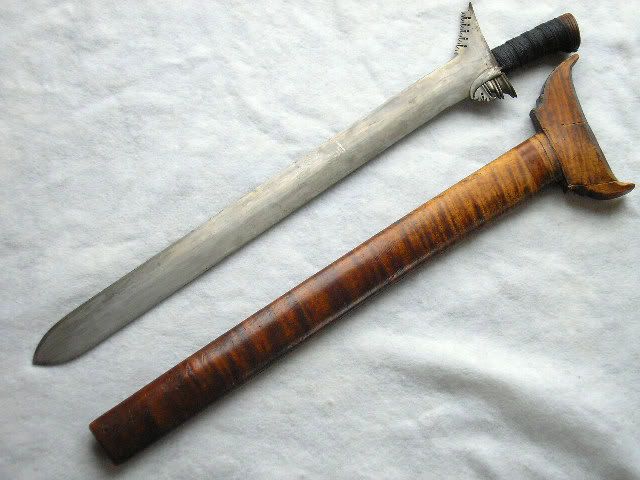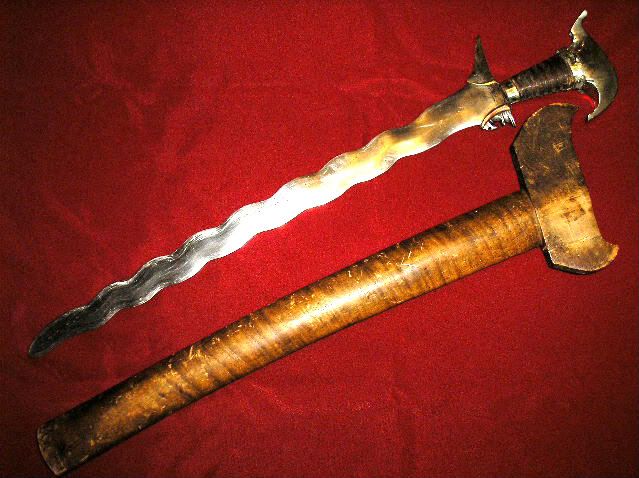
 |
|
|
|
|
#1 |
|
EAAF Staff
Join Date: Dec 2004
Location: Louisville, KY
Posts: 7,346
|
I would disagree with you on Spunger's kris - I had it in hand and the pommel is elephant ivory with grain structure indicative of elephant ivory. Also, ivory from India and Sumatra was traded in the reaching, including reaching the Philippines,China, and Japan.
|
|
|
|
|
#2 | |
|
Member
Join Date: Jun 2008
Posts: 89
|
Quote:
Smithsonian photographs do not even show krises with ivory handles. I also have a copy of thirteenth century text written by a chinese trader involved in ivory trading not with the people of sulu but with the lumads (natives) of palawan. |
|
|
|
|
|
#3 |
|
Member
Join Date: Dec 2004
Posts: 1,247
|
Hi Baganing,
This is a more general comment, rather than a specific response. I happen to work in the sciences, and there's this idea that some have called "scientific sexiness." It's when you fall head over heels in love with this wonderful idea, and then go out chasing it and trying to prove it's true. The problem with great ideas is that not all of them turn out to be so great once you get to know them. Yes, there are parallels between science and dating. In any case, what separates the good scientists from the bad ones isn't the sexiness of their ideas, it's that their sexy ideas stand up to cold, hard, often brutal scrutiny, primarily because they're testable, and withstand all attempts to refute them with the best evidence available. While I agree that you have to be a strong advocate for your ideas (and they are interesting), if you want to do truly good scholarship, you also need to find ways to test your ideas. If your ideas cannot be tested in a way that would disprove them, then they really aren't great. That's okay. I've got a closetful of sexy ideas. Most researchers do. My favorite unfulfilled sexy idea is waiting for someone discover 70 million year old fossil roots of a proto-oak from Burma--if such roots exist. Once someone finds those roots, I can write a paper that will change everyone's ideas about how plants evolved. But only if I'm right about what how those roots are constructed, and only if they exist. There may or may not be parallels between this story and trying to find a 600 year old kris to support your ideas. My 0.00002 cents. Back to lurking. Interesting thread! F |
|
|
|
|
#4 | |||
|
Member
Join Date: Dec 2004
Location: Witness Protection Program
Posts: 1,730
|
Quote:
Quote:
huh? how did you connect vikings and turks? i wish you could explain this further as this is very interesting. Quote:
|
|||
|
|
|
|
#5 | |
|
Member
Join Date: Jun 2008
Posts: 89
|
Quote:
You said the spanish introduced the "turko" to the philippines. Granting they did since Spain was not spared by the ottomans, they would have also introduced "vikingo" since vikings also invaded/raded spain. Why would they be selective about their history, if indeed they introduced the image or the word turko to the filipinos? anyway, I checked and compared the Y-Chromosome haplogroups of sumatra, borneo, and philippines. They all share the same haplogroups C,O,D, and K, but the only difference is that philippines has haplogroup R1B. Guess what... Turkey has R1b. I am not sure though if the haplogroup i thought to be R1B is right (the color is just too tiny and vague. Maybe it is RxR1. If it is the case, still there is a turkish connection, turkey has K (western asia or eurasia haplogroup) too, and that would mean, there are also turkish genes in sumatra and borneo like philippines. I need to go back home and ask my tausug friends for DNA testing. I have always believed that their ancestry can be traced back to turkey since I got a turkish boyfriend years ago who just looked like my tausug cousin. hehehehe y-chromosome haplogroups Last edited by baganing_balyan; 28th June 2008 at 12:00 PM. |
|
|
|
|
|
#6 | |||
|
Member
Join Date: Dec 2004
Location: Witness Protection Program
Posts: 1,730
|
so, what's your definition of old? as you said of my kris:
Quote:
Quote:
Quote:
turko. vikingo. lol, that's funny-o. |
|||
|
|
|
|
#7 | |
|
Member
Join Date: Jun 2008
Posts: 89
|
Quote:
I just told you in archaelogy, the development of tools is from simple to complex. The more intricate it looks, the more recent it is. if you are an antiquarian or antique collector, 1800 artifact is ancient. For anthropologists or historians ancient means centuries ago. Stop nitpicking. It was you who said turko was introduced by the spanish, and I refuted that idea since vikingo does not exist in our Lexicon. Bombay exists. It's because early Filipinos did meet early Indians, and there were indians living in cainta, rizal as early as mid 1700. As I studied Philippine languages, it seems that we don't have early names for foreigners our forefathers had not met. Vikingo is a case in point. Yes, I checked the DNA chart, Filipinos do not have any viking genes. By the way, I think the r1b I thought is actually rxr1 coming from the australian aborigines and cameroon, africa. It is explainable. We have negroid natives in the philippines such as aetas. Now why would Philippines sumatra, and borneo have a eurasian haplogroup? I think that's where the turkish ottomans enter the scene. |
|
|
|
|
|
#8 | |
|
Member
Join Date: Dec 2004
Location: Witness Protection Program
Posts: 1,730
|
Quote:
really? here's a Kris Espada dated 1899  now, here's a Kalis Seko from the early 1800's  and a museum piece i was fortunate enough to study, a Kris Luma from late 1700's/early 1800's  which is similar to one of our member's piece (VVV), and btw, with an Ivory pommel http://www.vikingsword.com/vb/showth...haic+moro+kris seems to be that the older pieces are more intricate than the newer one in this case. care to explain? again, you haven't answered my question on how do you know the alleged smithsonian pictures were old by your definition? turko is spanish. spanish conquered philippines. how hard is that? |
|
|
|
|
|
#9 | |
|
EAAF Staff
Join Date: Dec 2004
Location: Louisville, KY
Posts: 7,346
|
Quote:
Example: look at the Indus Valley civilization - very complex with complex artifacts in the 2nd millenium BC, but compare this to the 1st millenuim it looks like the appex of civilization. The same can also be said of the region of the Middle East around what is now Palestine over several periods where different peoples changed the level of complexity of artifacts (ie. after the arrival of the "Sea Peoples" or the arrival of Amorite tribes into the region). Thus a period of complexity in design or artifacts can be followed by a period of lower complexity (ie. the European "Dark Ages" after the fall of the Western Roman Empire). These kris may be older than you think and the use of ivory goes back millenia. |
|
|
|
|
|
#10 | |
|
Member
Join Date: Feb 2005
Location: Chicago area
Posts: 327
|
Quote:
My wife is a Cebuano & speaks the dialect. I gave her Pigafetta's list of words, he recorded in Cebu & she found a fairly small % that she recognized. & I am sure you are knowledgeable of the different meanings of the same word in the different Philippine dialects. But if you hear someone, in their dialect, say "air con" or "computer" you don't have to understand their dialect to know what the word means or from where it is derived. |
|
|
|
 |
|
|